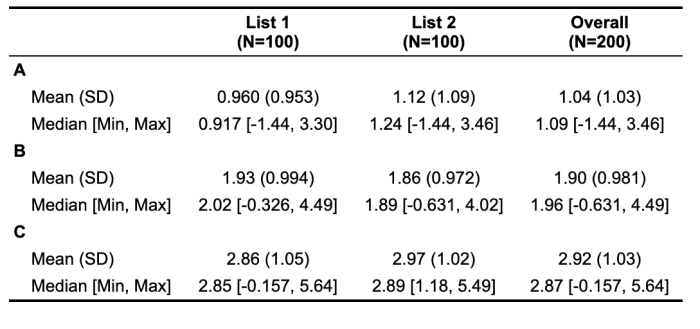Creating a summary statistical table from a data frame
Or using what you have already done, you just need to put those summaries into a list and use do.call
df <- structure(list(age = c(19L, 19L, 21L, 21L, 21L, 18L, 19L, 19L, 21L, 17L, 28L, 22L, 19L, 19L, 18L, 18L, 19L, 19L, 18L, 21L, 19L, 31L, 26L, 19L, 18L, 19L, 26L, 20L, 18L), height_seca1 = c(1800L, 1682L, 1765L, 1829L, 1706L, 1607L, 1578L, 1577L, 1666L, 1710L, 1616L, 1648L, 1569L, 1779L, 1773L, 1816L, 1766L, 1745L, 1716L, 1785L, 1850L, 1875L, 1877L, 1836L, 1825L, 1755L, 1658L, 1816L, 1755L), height_chad1 = c(1797L, 1670L, 1765L, 1833L, 1705L, 1606L, 1576L, 1575L, 1665L, 1716L, 1619L, 1644L, 1570L, 1777L, 1772L, 1809L, 1765L, 1741L, 1714L, 1783L, 1854L, 1880L, 1877L, 1837L, 1823L, 1754L, 1658L, 1818L, 1755L), height_DL = c(180L, 167L, 178L, 181L, 170L, 160L, 156L, 156L, 166L, 172L, 161L, 165L, 155L, 177L, 179L, 181L, 178L, 174L, 170L, 179L, 185L, 188L, 186L, 185L, 182L, 174L, 165L, 183L, 175L), weight_alog1 = c(70L, 69L, 80L, 74L, 103L, 76L, 50L, 61L, 52L, 65L, 66L, 58L, 55L, 55L, 70L, 81L, 77L, 76L, 71L, 64L, 71L, 95L, 106L, 100L, 85L, 79L, 69L, 84L, 67L)), class = "data.frame", row.names = c("1", "2", "3", "4", "5", "6", "7", "8", "9", "10", "11", "12", "13", "14", "15", "16", "17", "18", "19", "20", "21", "22", "23", "24", "25", "26", "27", "28", "29"))
tmp <- do.call(data.frame,
list(mean = apply(df, 2, mean),
sd = apply(df, 2, sd),
median = apply(df, 2, median),
min = apply(df, 2, min),
max = apply(df, 2, max),
n = apply(df, 2, length)))
tmp
mean sd median min max n
age 20.41379 3.300619 19 17 31 29
height_seca1 1737.24138 91.919474 1755 1569 1877 29
height_chad1 1736.48276 92.682492 1755 1570 1880 29
height_DL 173.37931 9.685828 175 155 188 29
weight_alog1 73.41379 14.541854 71 50 106 29
or...
data.frame(t(tmp))
age height_seca1 height_chad1 height_DL weight_alog1
mean 20.413793 1737.24138 1736.48276 173.379310 73.41379
sd 3.300619 91.91947 92.68249 9.685828 14.54185
median 19.000000 1755.00000 1755.00000 175.000000 71.00000
min 17.000000 1569.00000 1570.00000 155.000000 50.00000
max 31.000000 1877.00000 1880.00000 188.000000 106.00000
n 29.000000 29.00000 29.00000 29.000000 29.00000
How to create a summary statistics table for transformed variables in r
You can just call log on the data you want to summarise first.
For example:
Untransformed summary:
> mtcars |> select(hp, drat, wt) |> summary()
hp drat wt
Min. : 52.0 Min. :2.760 Min. :1.513
1st Qu.: 96.5 1st Qu.:3.080 1st Qu.:2.581
Median :123.0 Median :3.695 Median :3.325
Mean :146.7 Mean :3.597 Mean :3.217
3rd Qu.:180.0 3rd Qu.:3.920 3rd Qu.:3.610
Max. :335.0 Max. :4.930 Max. :5.424
Tranformed:
> mtcars |> select(hp, drat, wt) |> log() |> summary()
hp drat wt
Min. :3.951 Min. :1.015 Min. :0.4141
1st Qu.:4.570 1st Qu.:1.125 1st Qu.:0.9479
Median :4.812 Median :1.307 Median :1.2009
Mean :4.882 Mean :1.269 Mean :1.1217
3rd Qu.:5.193 3rd Qu.:1.366 3rd Qu.:1.2835
Max. :5.814 Max. :1.595 Max. :1.6908
Create and Export a Summary Statistics Table
You have a tibble and stargazer doesn't support it. If you change it to dataframe it works.
library(stargazer)
data_stuct <- data.frame(data_stuct)
stargazer(data_stuct[c("BNBClose", "BTCClose", "ADAClose", "LINKClose",
"DODGEClose")],type="text",title="Summary Statistics", out="table1.txt")
#Summary Statistics
#========================================================================
#Statistic N Mean St. Dev. Min Pctl(25) Pctl(75) Max
#------------------------------------------------------------------------
#BNBClose 10 1.568 0.219 1.217 1.411 1.659 1.965
#BTCClose 10 4,507.324 220.613 4,229.360 4,339.010 4,731.635 4,826.480
#ADAClose 10 0.022 0.002 0.019 0.021 0.022 0.026
#LINKClose 10 0.408 0.043 0.346 0.385 0.440 0.476
#DODGEClose 10 0.001 0.00004 0.001 0.001 0.001 0.001
------------------------------------------------------------------------
How create summary table for every column?
Of coruse, Pandas have a method for that - describe():
df.describe()
Which gives more statistics than you requested. If you are interested only in mean and std, you can do:
df.describe()[['mean', 'std']]
How to create a dataframe of summary statistics?
You can pass a dict of functions to a groupby to perform the stats using agg:
In [154]:
df.groupby('ID')['Variable_1'].agg({'Mean':np.mean, 'SD':np.std})
Out[154]:
Mean SD
ID
1234 27.5 6.363961
2345 65.0 11.000000
3456 78.0 NaN
Is there a way in R to create summary statistics table from a list of data
We can use transpose from purrr and flatten or unlist the list elements to be a list of 3
library(purrr)
DF2 <- transpose(DF) %>%
map(flatten_dbl)
NOTE: DF is the second dataset in the OP's post
Now, we test with table1
table1::table1(~A+B+C, data=DF2, overall = 'List 1')
-output

If we need to create a two column table, convert the list of list of vectors to a single data.frame while creating a column with the names of the outer list element
new_DF <- do.call(rbind, Map(cbind, nm1 = names(DF),
lapply(DF, as.data.frame)))
row.names(new_DF) <- NULL
table1::table1(~ A + B + C |nm1, data = new_DF)
-output

Create a summary table from my data.frame
You can use the aggregate function on two variables and use sum in the FUN argument.
summaryDf <- aggregate( data = df , cbind(nkill, nwound) ~ country_txt.factor, FUN = sum)
Related Topics
Remove Rows from Data Frame Where a Row Matches a String
How to Flatten a List of Lists
Remove Ids That Occur X Times R
Reverse Order of Discrete Y Axis in Ggplot2
How to Read Only Lines That Fulfil a Condition from a CSV into R
Proper Idiom for Adding Zero Count Rows in Tidyr/Dplyr
Re-Ordering Factor Levels in Data Frame
Changing Font Size and Direction of Axes Text in Ggplot2
Automatically Delete Files/Folders
Code to Import Data from a Stack Overflow Query into R
Non-Equi Join Using Data.Table: Column Missing from the Output
Using Lists Inside Data.Table Columns
Split Date into Different Columns for Year, Month and Day
Count Values Separated by a Comma in a Character String
How to Change Library Location in R
Linear Regression Loop for Each Independent Variable Individually Against Dependent